Up to 50% Clearance Clothing & Footwear + Extra 25% Off REI Outlet.
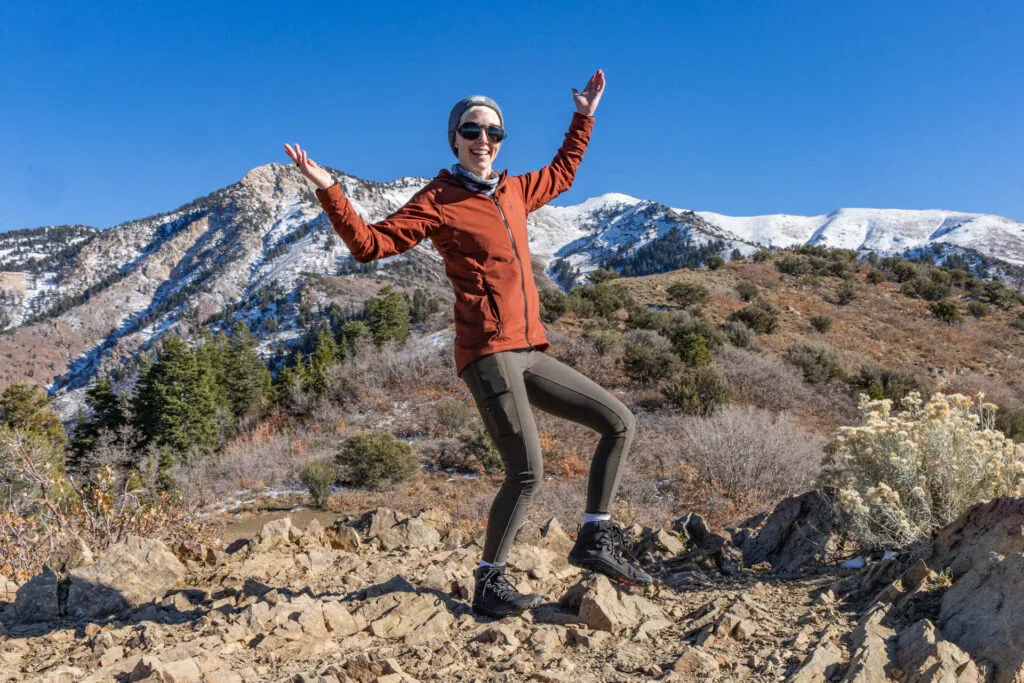
I love hiking in leggings. The freedom of movement they offer, the comfort, the ease of use…it’s all unparalleled. But typical yoga leggings aren’t always the best for outdoor adventures. They snag easily, sometimes don’t dry fast enough, and often don’t have pockets–or at least secure ones (btw, ask me how I feel about women’s clothing without pockets…😑). Hiking tights, on the other hand–also known as trekking tights or hiking leggings–are designed to stand up to the rigors of the outdoors. And as we know, durability is a cornerstone of sustainability. So if you love leggings but are looking for something more durable, read on.
What are hiking tights, exactly?
Hiking leggings, like yoga tights, are still fitted, still offer full range of motion, are still stretchy and super comfortable. But they take it all a step further. Hiking tights tend to be made of more robust materials and offer more features than your yoga pants.
Trekking tights typically feature:
- More durable and/or abrasion-resistant fabric.
- Pockets, including secure zipper pockets.
- A no-sag fit.
That’s because in addition to being comfortable, they have to stand up to the rigors of outdoor environments and all the natural hazards that come with them. For example, if you brush against a bush, they need to not snag or tear. When you sit on a rock, the butt needs to not turn into a pilled mess like the bottoms of your cheap swimwear from childhood the first time you sat on the cement to dangle your feet in the pool. And they need to have space to stash all the necessities, like lip balm, travel-size sunscreen, keys, your favorite pocket knife, a map, and maybe a cold cider for the summit (just me?).
As in, they need to perform at least as well as your favorite pair of hiking pants or they’re simply not worth it.
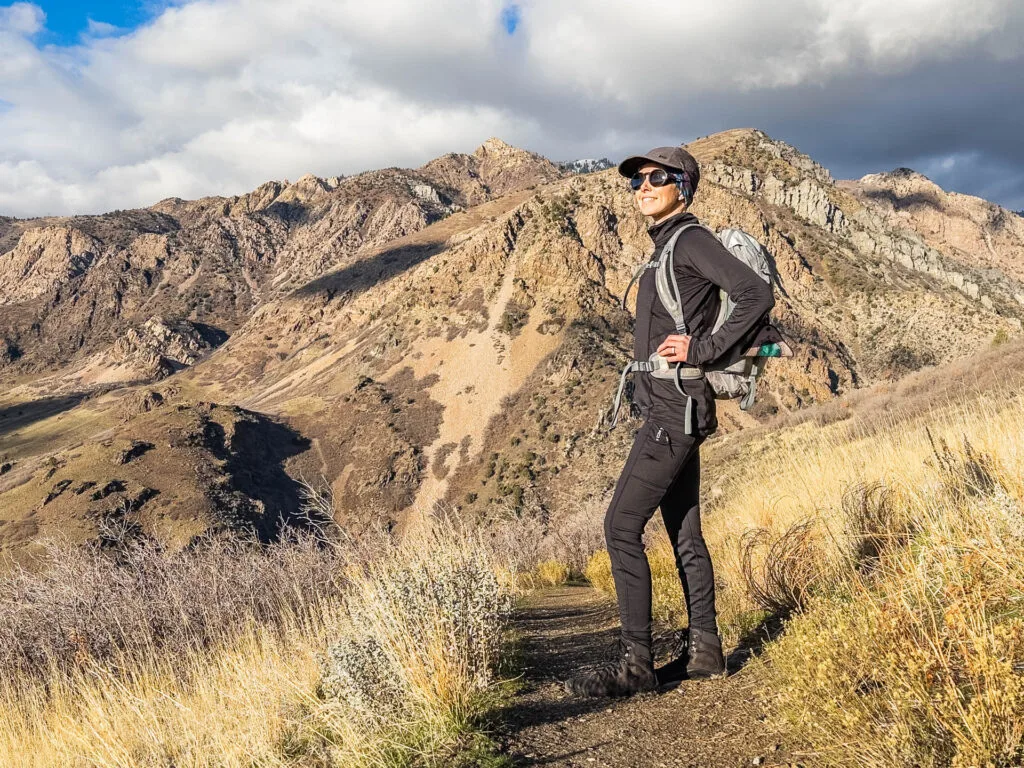
Why Wear Hiking Tights Instead of Pants?
Listen, what you choose to wear when you hike is about as personal as what snacks you stuff in your trendy hip pack. And if you’re reading this, you’re probably already on team trekking tights. But if you’re on the fence, here’s why they’re great:
- You can seriously move. Unlike with pants, especially those with limited stretch, you have full and complete range of motion in hiking leggings. They restrict nothing. Which means you can enjoy your time outside without thinking about pant legs holding you back or getting in the way.
- If you hate excess fabric on your skin like I do, especially in those in-between temps that hover uncomfortably between pants-weather and shorts-weather, hiking tights make a great crossover article of clothing: not too hot, too cold, or too clingy.
- They make layering easy in cold weather. For example, when I’m hiking in cool to cold conditions, I may start out in a base layer–leggings–under a pair of hiking pants. Then, if I start getting too warm on a long hike, I can remove my outer layer and still be outfitted in a functional pair of hiking tights.
- They’re moisture-wicking and quick-drying.
- They’re just so dang comfortable. I mean, I don’t have to tell you that…
- Easy on, easy off. Extra nice if you’ll be pulling them up and down to go to the bathroom in the woods (though our beloved Gnara pee pants are our absolute fave for easy bathroom breaks).
- They lay flat and are no-fuss under backpack hip straps.
What are the Downsides of Hiking Tights?
Of course, no article of clothing is perfect for every adventure, and that includes leggings designed for hiking.
- They’re not usually water resistant (and if they are, they likely contain PFAS, which are terrible for the environment).
- They’re not windproof, so if it’s cold and blowing, they ain’t stopping’ nothin’.
- They may not be as durable or long-lasting as a *quality* pair of hiking pants.
- If you sweat a lot, that fact may be more evident in anything but black leggings.
So you have the pros and cons of hiking tights. If you’re still thinking they’re right for you, these are some more sustainable options for your next adventure.
More Sustainable Hiking Tights
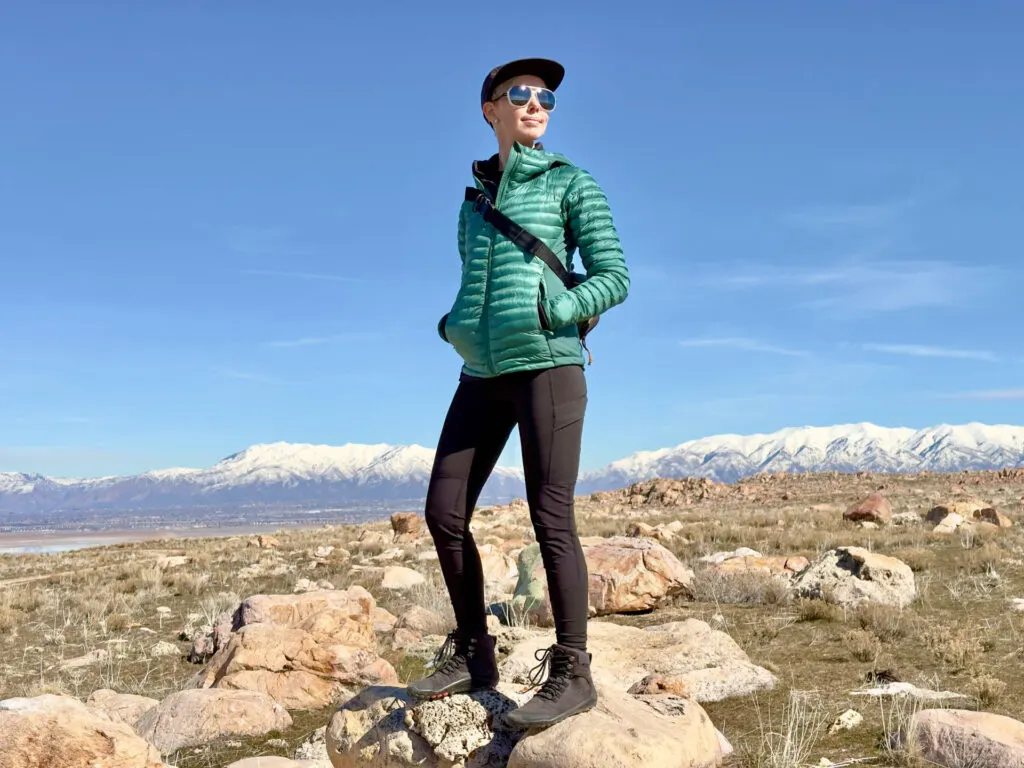
Mammut Zinal Hybrid Tights
Personally, when I think of hiking tights, the Zinal Hybrid is exactly what I picture. Which is why these are my favorite leggings on this list. They fit snuggly, are water resistant (but don’t contain any PFAS), and feature extra durable material on the butt and knees so you don’t have to worry about snagging the fabric when you sit on a rock or kneel in the dirt. Win! Plus they’re easy-on, easy-off, don’t pinch in any weird places, and are suitable for cool weather (though they’re not lined or anything).
They also have two large side pockets plenty big enough for a phone (plus other items like lip balm or a small tube of sunscreen). The pocket on the right has a secure zipper and the one on the left has a flap over the opening so nothing will accidentally fall or bounce out while you’re hiking or trail running or mountain biking. Plus they come in a handful of neutral colors (currently sage green, navy, and black). They may be the most expensive on this list, but in my opinion, they’re worth it. If you’re between sizes, consider sizing up instead of down to prevent seems from digging in.
Price: $129
Pros:
- Nice athletic fit.
- Two secure drop pockets on the sides.
- Durable fabric on the butt and knees.
- Bluesign approved, PFC-free, Fair Wear, and made of partially recycled materials.
Cons:
- Stitched seams can feel a bit tight if you’re between sizes and sized down.
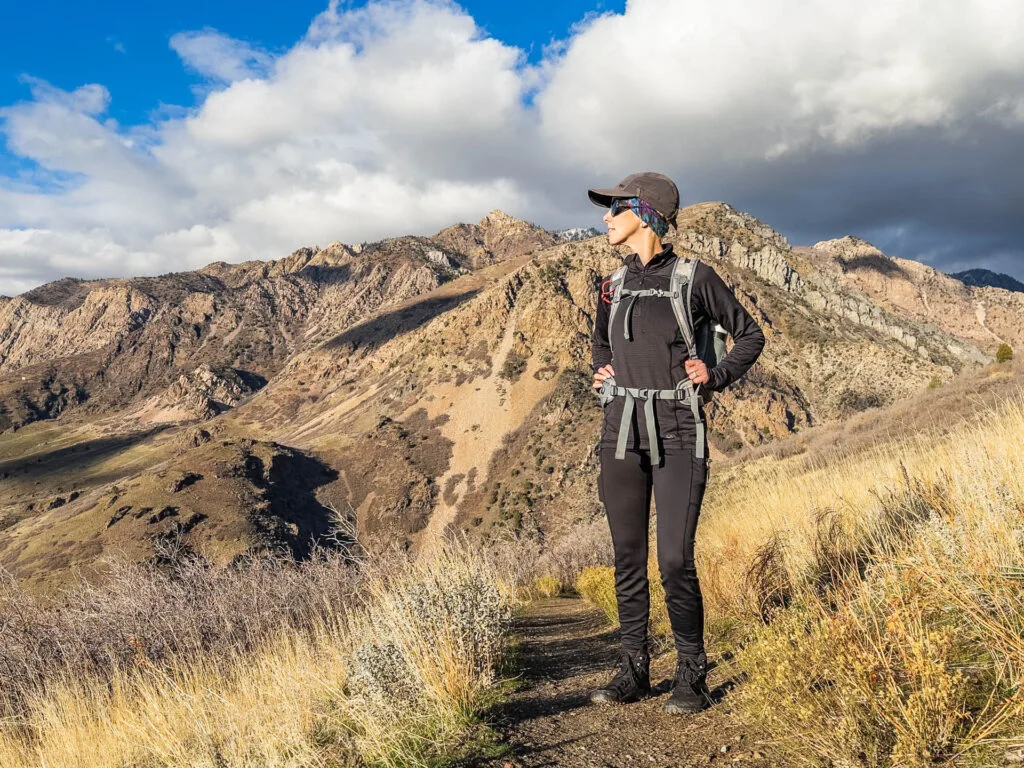
Patagonia Pack Out Tights
If you’re looking for a pair of trekking tights for cooler climates, look no further than the Patagonia Pack Out Tights. They’re made of 87% recycled materials that are also Bluesign Approved, crafted in a Fair Trade Certified factory, and are a bit thicker than the other options on this list (though not fleece-lined or anything), which means they’ll keep you warmer on cool morning hikes (but may be a bit too sweaty for summer). They feature two deep drop-in side pockets plus a secure zipper pocket on one side, but no little key pocket on the inside of the waistband (if that’s important to you–personally, I never use it anyway).
As for sizing, Patagonia tends to be all over the place when it comes to their fitted layers. For example, I tested a pair of the brand’s Endless Run Shorts in XS and they were too tight. I tested a size small in these and they were too big. So consider sizing down when you order if you tend to be on the line between sizes, or at least don’t size up. On the upside, they’re available in sizes XS-XXL.
Price: $119
Pros:
- Thicker fabric keeps you warmer in cool temps.
- Deep pockets offer plenty of space for stashing important stuff, including large phones.
- Made of sustainable materials in a Fair Trade factory.
- Comes in the widest range of sizes.
Cons:
- The material doesn’t feel as high quality as you might expect from Patagonia.
- No abrasion-resistant fabric.
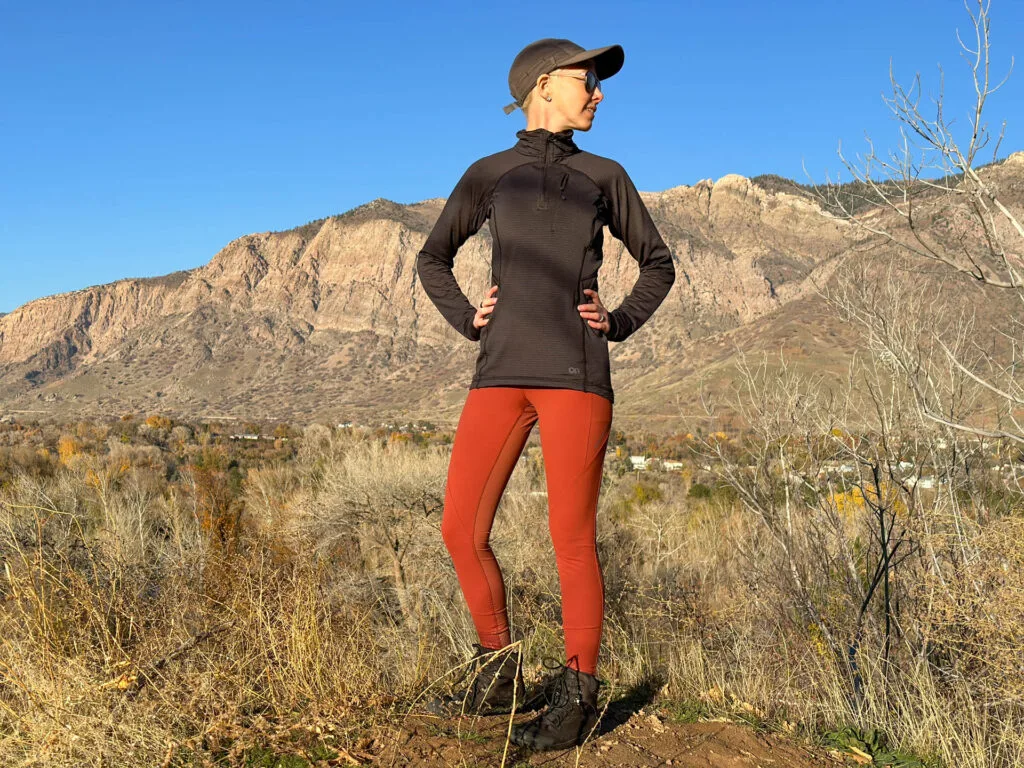
Outdoor Research Ferrosi Hybrid Legging
The Outdoor Research Ferrosi Hybrid Legging is a delightful option when it comes to trekking tights and may be my favorite on this list. The nylon fabric on the front is soft to the touch, but the whole back is made of a more durable, Bluesign Ferrosi fabric (the brand’s specialty hiking apparel material). They’re flattering, the wide waistband is snug and supportive and stays put, and every seam is pure quality. Plus the pockets–including a zipper pocket–are spacious and there’s a patterned overlay on the inside of the ankles to help prevent wear if you tend to scrape your boots on your pants when you walk.
They come with the brand’s Infinite Guarantee, meaning OR guarantees these tights will perform for the life of the product. That only covers defects in manufacturing, not wear-and-tear, but still. They come in 3 colors and in sizes XS-XL, but sizing is tricky. The ankle seams and top of the waistband hardly stretch at all. While the XS I tested fit nicely in the legs and butt, the ankles were difficult to pull over my heels, the waistband tricky to maneuver over my (small) hips, and then the top of the high rise band was tight around my waist. Tight enough to squeeze uncomfortably, meaning I probably would have been better off with a size small. So consider sizing up. And if you have wide hips or larger than “normal” feet, you may want to look elsewhere for hiking tights.
Price: $110
Pros:
- The back of the tights is made of more durable material.
- The front fabric is super soft to the touch.
- Pockets are deep enough for most phones.
- A secure zipper pocket keeps valuables safe.
- They’re partially made of Bluesign materials.
Cons:
- The waistband and ankles aren’t very stretchy, so sizing and pulling them off and on can be difficult.
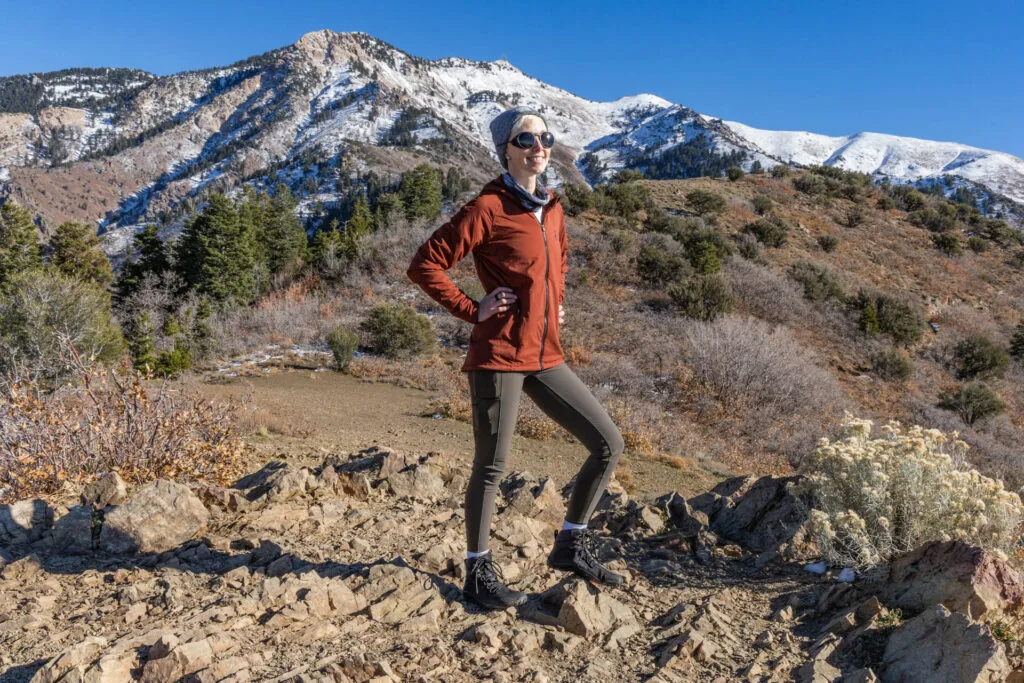
Cotopaxi Verso Hike Tight
The Versa Hike Tight is constructed of a nice heavy, comfortable fabric, with a double layer of more durable fabric on the front to help block wind and resist abrasion if you’re hiking through foliage or scrambling over rocks. They have two large drop-in pockets on the side that are just big enough for an average cell phone, plus a small zippered side pocket for things like keys or cash.
The waist comes up nice and high on these leggings, but they don’t have that traditional waistband panel all the way around, so if you prefer a bit more compression in that area or don’t have curvy hips to help keep the waistband in place, these might not be for you. They run pretty true to size, though perhaps a bit small, but only in the legs (I wore an XS). As in, the waistband wasn’t particularly snug on me (a small would have been too big), but the legs were tight, and as a result, they continually crept downward and sagged throughout my hike; I had to keep pulling them back up. To me, that says these are probably best suited for body types with larger waists and thinner legs. They’re available in XS-XL.
Price: $115
Pros:
- Available in 4 fun color combos if that’s your thing.
- Abrasion-resistant fabric on the front.
- Just the right amount of compression.
- Soft fabric.
- Comfortable to wear.
Cons:
- No abrasion-resistant material on the rear.
- Proportions made them creep downward on me.
Bottom Line
Hiking tights are a nice thing to have in your trail clothing quiver. Personally, I love the freedom of movement they provide and that they can do double duty as a base layer in cooler months to keep your legs warm. But before you buy, especially because sizing for hiking tights seems to be all over the place and the materials they’re made of less forgiving than standard yoga leggings, consider trying a pair on in-store to reduce the chance that you’ll have to return them. Also, consider buying used! We love used gear here at Terradrift because it’s often more affordable and always more sustainable!
What do you think of these options? Tried any? Want to? Let us know! Then suit up and wander on!
•
This post contains affiliate links, which means when you clicky-click and make a purchase, we may receive some compensation. Don’t worry, it won’t cost you any extra, but you will be supporting Terradrift! That’s what we call a win-win!
Alisha is a freelance outdoor journalist and photographer based in Ogden, UT. She loves backpacking, hiking, mountain biking, kayaking and snowboarding (even though she’s terrible at it). She’s also pretty sure she’s addicted to coffee. alishamcdarris.com
